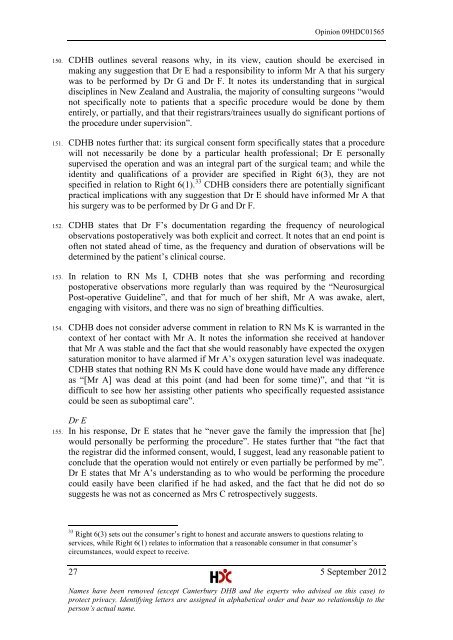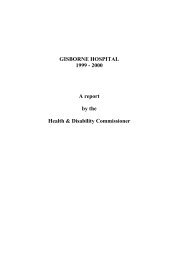09HDC01565 - Health and Disability Commissioner
09HDC01565 - Health and Disability Commissioner
09HDC01565 - Health and Disability Commissioner
Create successful ePaper yourself
Turn your PDF publications into a flip-book with our unique Google optimized e-Paper software.
Opinion <strong>09HDC01565</strong><br />
150. CDHB outlines several reasons why, in its view, caution should be exercised in<br />
making any suggestion that Dr E had a responsibility to inform Mr A that his surgery<br />
was to be performed by Dr G <strong>and</strong> Dr F. It notes its underst<strong>and</strong>ing that in surgical<br />
disciplines in New Zeal<strong>and</strong> <strong>and</strong> Australia, the majority of consulting surgeons ―would<br />
not specifically note to patients that a specific procedure would be done by them<br />
entirely, or partially, <strong>and</strong> that their registrars/trainees usually do significant portions of<br />
the procedure under supervision‖.<br />
151. CDHB notes further that: its surgical consent form specifically states that a procedure<br />
will not necessarily be done by a particular health professional; Dr E personally<br />
supervised the operation <strong>and</strong> was an integral part of the surgical team; <strong>and</strong> while the<br />
identity <strong>and</strong> qualifications of a provider are specified in Right 6(3), they are not<br />
specified in relation to Right 6(1). 33 CDHB considers there are potentially significant<br />
practical implications with any suggestion that Dr E should have informed Mr A that<br />
his surgery was to be performed by Dr G <strong>and</strong> Dr F.<br />
152. CDHB states that Dr F‘s documentation regarding the frequency of neurological<br />
observations postoperatively was both explicit <strong>and</strong> correct. It notes that an end point is<br />
often not stated ahead of time, as the frequency <strong>and</strong> duration of observations will be<br />
determined by the patient‘s clinical course.<br />
153. In relation to RN Ms I, CDHB notes that she was performing <strong>and</strong> recording<br />
postoperative observations more regularly than was required by the ―Neurosurgical<br />
Post-operative Guideline‖, <strong>and</strong> that for much of her shift, Mr A was awake, alert,<br />
engaging with visitors, <strong>and</strong> there was no sign of breathing difficulties.<br />
154. CDHB does not consider adverse comment in relation to RN Ms K is warranted in the<br />
context of her contact with Mr A. It notes the information she received at h<strong>and</strong>over<br />
that Mr A was stable <strong>and</strong> the fact that she would reasonably have expected the oxygen<br />
saturation monitor to have alarmed if Mr A‘s oxygen saturation level was inadequate.<br />
CDHB states that nothing RN Ms K could have done would have made any difference<br />
as ―[Mr A] was dead at this point (<strong>and</strong> had been for some time)‖, <strong>and</strong> that ―it is<br />
difficult to see how her assisting other patients who specifically requested assistance<br />
could be seen as suboptimal care‖.<br />
Dr E<br />
155. In his response, Dr E states that he ―never gave the family the impression that [he]<br />
would personally be performing the procedure‖. He states further that ―the fact that<br />
the registrar did the informed consent, would, I suggest, lead any reasonable patient to<br />
conclude that the operation would not entirely or even partially be performed by me‖.<br />
Dr E states that Mr A‘s underst<strong>and</strong>ing as to who would be performing the procedure<br />
could easily have been clarified if he had asked, <strong>and</strong> the fact that he did not do so<br />
suggests he was not as concerned as Mrs C retrospectively suggests.<br />
33 Right 6(3) sets out the consumer‘s right to honest <strong>and</strong> accurate answers to questions relating to<br />
services, while Right 6(1) relates to information that a reasonable consumer in that consumer‘s<br />
circumstances, would expect to receive.<br />
27 5 September 2012<br />
Names have been removed (except Canterbury DHB <strong>and</strong> the experts who advised on this case) to<br />
protect privacy. Identifying letters are assigned in alphabetical order <strong>and</strong> bear no relationship to the<br />
person’s actual name.
















